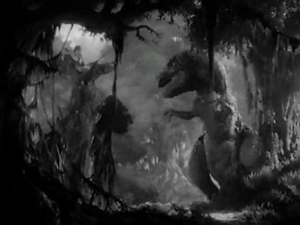
Tonight I’d like to talk about heresy. Everyone’s committed at least one over the course of their movie-watching lives. You know what I’m talking about. Deep inside your heart there’s at least one universally-acclaimed film you can’t stand. More likely there’s a whole list which you’ll be all too glad to rattle off should anyone make the mistake of asking.
For some it’s that ninety minute Vangellis music video that happens to star Harrison Ford, Blade Runner. For some it’s Star Wars. They just don’t get it, and they’ll tell you that ’til they’re blue in the face. For some it’s The Godfather; for some, Citizen Kane. For some it’s The Wizard of Oz, or the great biblical epics of the ’50s. But not me. I’ve got nothing against those films. I don’t have the hate to waste. I’d rather keep it all for King Kong.
And before you start, yes, I am all-too aware of the debt I owe this film, personally and professionally (since I seem to have gone and made the personal my profession). Without King Kong there would be no The Beast from 20,000 Fathoms. Without The Beast (which was one of Kong‘s first titles) there would be no Godzilla. Without Godzilla there would be no Godzilla: 1985 and an impressionable five-year-old version of myself would never have gotten into monster movies.
None of which changes the fact Kong is a poorly-paced racist fantasy that only looks weirder as time goes on. For example, it begins with the most famous fake-Arab proverb in all existence:
“And lo, the beast looked upon the face of beauty. And it stayed its hand from killing. And from that day, it was as one dead.”
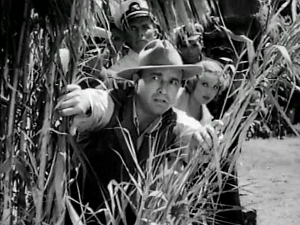
A proverb producer Merian C. Cooper made up on the spot when he decided to literally spell the theme out for us first thing after the opening credits. Just in case we fall asleep during the overture.
We open on a dock in New York and plunge into one of the most densely-packed Exposition Storms in history. Stop me if you’ve heard this one. Carl Denham (Robert Armstrong) is a hot-shot movie producer, legend in his own time/mind, and obvious authorial cipher. Denham’s hired the S.S. Venture under Captain Not-Worth-A-First-Name Englehorn (Frank Reicher) to take him to a location he refuses to disclose, nevertheless swearing that, “They’ll have to think up a lot of new adjectives when I get back!”
To make matters worse, monsoon season’s bearing down on them, the insurance company’s found out about all the guns and gas bombs they’re carrying, and only one theatrical agent in New York, Weston (Sam Hardy), will even give Denham the time of day. He won’t give Denham a lead actress, but at least he’ll show up to say so in person and feed Denham lines.
“You’ve never had a woman in any of your other pictures. Why do you want one in this.”
“Holy mackerel, do you think I wanna haul a woman around?”
“Then why?”
“Because the public…bless ’em, must have a pretty face to look at.”
“Sure. Everybody likes romance.”
“Well, isn’t there any romance in the world without having a flapper in it?”
“Well, Mr. Denham, why don’t you make a picture in a monastery?”
“…makes me sore. I go out and sweat blood to make a swell picture, and the critics and the exhibitors all say, ‘If this picture had Love Interest it would gross twice as much.’
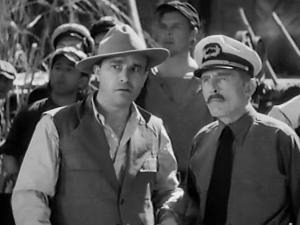
Ah, the 1930s…when producer/directors actually bothered to blame critics and exhibitors for their shitty movies. Little did they know that all they and their studio bosses had to do was buy up the company that owns the newspaper that employs the critic. Then all you have to do is pay the critic a little more, put an out-of-context quote from their review on the top of the movie poster, sell more tickets, make more money, buy up more companies, and you’re home free. Not like there were laws preventing that sort of thing in 1933…but that’s a whole ‘nother diatribe.
So Denham resorts to prowling the streets and manages to find the most beautiful woman in New York stealing an orange off a vendor. Since she’s a girl, she swoons into Denham’s arms and we get to see Denham make his date rape-face as he calls for a taxi.
“You’re very kind.”
“Don’t you fool yourself. I’m not bothering about you just out of kindness.”
The girl is Ann Darrow and, at the nearest drug store, Denham uses his name and his great line about adventure and fame and the thrill of a lifetime to dazzle Ann into accepting his offer. Not that she could refuse. It’s a Cinderella story before Cinderella (the Disney version, which was twenty years from completion); the perfect opportunity for an aspiring actress in the middle of the Great Depression. So the Venture leaves and, like all good Cinderella stories, this one quickly dissolves into physical and verbal abuse.
“What are you doin’ up here?”
“I just wanted to see!”
“Oh, you just wanted to see? Well I’m sorry – Make that line fast! – You’re that girl Denham picked up last night, aren’t ya?”
“Yes. I think all of this is terribly exciting. I’ve never been on a ship before.”
“Well, I’ve never been on a ship with a woman before.”
“I guess you don’t think much of women on ships, do you?”
“Nah, they’re a nuisance!”
“Well, I’ll try not to be.”
“You’ve been in the way already.”
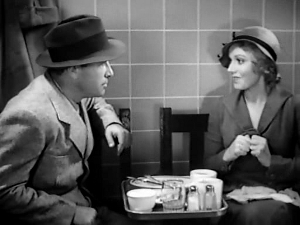
In all fairness, Jack does apologize for hitting Ann. That first time really was an accident and this actually does reflect an old sailors’ superstition. Women’re bad luck, you see. So remember, boys: aside from bleeding every month, whining about your lack of ambition and/or drive, and taking every opportunity to emasculate you with biting comments that always manage to cut way too deep, women doom your ship and crew to death on the high seas. It’s just one of those things.
Now that we’re at sea, the racist caricatures can fly hot and fast. I’ve ignored the sidewalk fruit vendor and the Old Man on the docks because they’re relatively minor characters. But I can’t ignore Charlie, the ship’s cook, played by actual-Chinese person Victor Wong. This is his third film in a career that outlasted World War II, almost all of it in uncredited roles. Like this here. On the one hand, you have to admire an actor who can spout this dialogue with a straight face. On the other hand:
“Some day me go back China and never see potato again!”
With that, Team Racism takes a commanding lead! But here comes star player Jack Driscoll to win things back for Team Sexism:
“Oh dear, and I thought everything was going so nicely.”
“Oh, you’re alright, but women…women just can’t help being a bother. Made that way, I guess.” (This really should be the “Arab proverb” in the opening credits.)
There’s some foreshadowing here with the ship’s monkey…which, now that I think about it, handily foreshadows Ann and Jack’s budding relationship…Denham breaks things up to order Ann into wardrobe. Jack asks where the Venture‘s headed again. Denham tries to distract us from wondering how he convinced anyone to go along with this thing by reciting the theme of his picture…and this one.
“I’ve never knew it to fail. Some big hardboiled egg gets a look at a pretty face and–bang!–he cracks up and goes sappy.”
“Now who’s going sappy?”
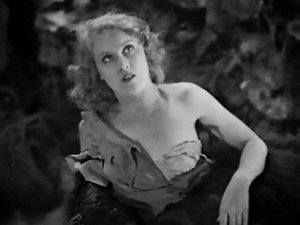
Denham incorrectly identifies this with the old myth of “beauty and the beast.” There are plenty of versions of that myth, but none of them deal with such baldfaced, paranoid, emasculation fantasies. In its oldest written versions, Beauty and the Beast is one of the first truly middle-class fables. The daughter of what Our Glorious Leaders would call a “small business owner” marries into the upper class by learning the look past the brutish exterior of the rich asshole who kidnapped her and see the handsome prince within.
Problem is, you can’t look at King Kong through the lens of that fable and not come up with a bunch of unfortunate implications. Ann’s Beauty, obviously. So who’s her rich kidnapper? It’s supposed to be Kong, but really, Carl Denham got to her first, ensnaring her with his promises of fame and fortune. Sure, it’s not like her father tired to steal one of his roses but, if he had, the movie would just have to waste time developing Ann’s character. God knows that’s the last thing it wants. Not that the classical versions of Belle were dynamic protagonists…but at least she got to show off the usual fairy tale-girl traits of virtue, courage, selflessness, and crying.
Here, we see Ann scream for the cameras in a scene that must’ve been lifted wholesale from this film’s actual casting process. See, Kong’s meant to be the Beast but Ann screams for Denham first. The Beast, in case you couldn’t guess, is the duality in every man, the instinctual and social urges surging through the most handsome prince and the scruffiest bum alike. But King Kong can’t admit that. Oh, no. After all, we’ve got a cast of stalwart heroes here. They can’t admit the least evidence of their unseemly urges. The Beast must be externalized, and at all cost. He must be Other, since Jesus would never allow him to become Us.
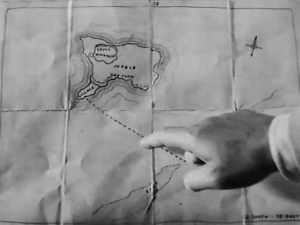
Now comes Skull Island, and the first big plot hole in King Kong. I don’t mean the map to the uncharted island (complete with coordinates, allowing people to locate it on any ol’ chart they please). Despite what Harlan Ellison might think, Denham actually explains where he got his map. As with everything else, Robert Armstrong does a bang-up job selling the story and the scene to us. He carries most of the film, and the script tries its damnedest to Designate him a Hero, despite all the death and destruction he causes. I’ll have a lot of awful things to say about Denham’s character over the course of this (as if that “date rape-face” joke didn’t clue you in), but I have nothing against the great actor portraying him. That goes for everyone in the cast. Even Bruce Cabot manages to make his patronizing sexism sound authentic and, once the chips are down, he looks good crawling through a jungle, being the Action Star he probably would’ve been if he’d gotten that part in Stagecoach instead of John Wayne.
And for all my jokes, I have to credit screenwriter Ruth Rose for adding a degree of verisimilitude to everyone’s Venture-bound interactions. Rose actually fulfilled the Ann Darrow role for previous Merian Cooper/Ernest B. Schoedsack expeditions (where she did significantly more to pull her weight than Ann does here). By this point, Schoedsack and Rose had been happily married for almost a decade, and Rose made sure to punch up this – the most ponderous part of the script – with a re-purposed version of her’s and Schoedsack’s initial romancing of each other aboard a 1926 expedition to the Galapagos Islands.
No, it’s Skull Island I won’t buy. Here Kong‘s asking me to believe a human community larger than a football team has, somehow, managed to survive on the small, sandy peninsula of an isolated island teaming with prehistoric creatures. Despite the fact that, for the next hour, King Kong will provide overwhelming evidence that Skull Island is the deadliest fucking place on Earth.
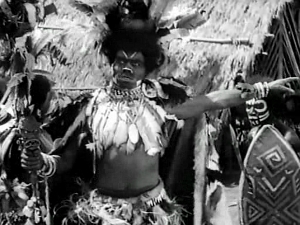
You’re telling me an advanced civilization once ruled over this island at some time in the distant past, going so far build a wall to protect its beachhead against daikaiju attack? Who were these people? Atlantians? The Mu? The Seatopians from Godzilla vs. Megalon? Where’d they go? Why’d they pull out and leave their people to devolve into a isolationist, sacrificial cult on the ass end of nowhere? If all the arable land’s overrun by dinosaurs, where do these people grow food? To support this kind of population, that “sandy peninsula” would have to be the size of a Florida Key, which in turn would make the whole island the size of Sri Lanka. Even though you can cross it in a day…and re-cross it in even less time if the plot requires.
Speaking of plot convenience, the Venture-ers happen to stumble across Skull Island’s one village just in time for the annual Gorilla Ceremony, wherein the natives offer up a bride to their heathen god, Kong. The Chief (Noble Johnson) spots this great big mass of white meat when Denham tries to film their ceremony. Tensions ramp up when the local witchdoctor (Steve Clemente) insists their ceremony’s been contaminated by the presence of intruders. Things cool down once the Chief notices Ann and offers to trade six of his wimmin-folk for the one blond (some gentleman, this one). Denham and Captain Englehorn refuse and retreat back to the ship, attempting to mollify the natives with their promise to return and make friends.
But we all know Denham buggered any chance of that happening, so what follows is more than inevitable: it’s necessary. Kong‘s another one of those Blooming Onion Plots, each section a grand exercise in setting up the next. Now that we’re on the Island the real movie can begin with Ann’s kidnapping via a native boarding party and Charlie the Chinese Cook’s immortal line, delivered to the Captain after Charlie discovers a necklace Ann’s struggles knocked off:
“Skipper, look! Crazy black man been here!”

I bitch about the racism because…well, it rubs me the wrong way. But I’ll admit, on occasion, it’s laugh-out-loud funny for all the wrong reasons. Like the Chief’s headdress, or the fact Ann never once tries running from the natives. (Damnit, woman, one shot to the nads and you’d at least get a head start!) No, she’s tied to an alter on the other side of a wall, so that the being Merian Cooper called “the tallest, darkest leading man in Hollywood” can pick her up and carry her off while she’s (of course) screaming in terror.
I’m not even going to touch the bestiality subtext. There’ll be time enough for that once we get to Mighty Joe Young. But it’s made worse by all the knowledge I’ve accrued in the years since I first wondered, “Why in God’s name would anyone want to kidnap Ann Darrow?” Her screams are a bucket of glass shards poured right into your ear. I can only imagine what they sound like to Kong. Gorillas are smart and, like most intelligent beings, they get bored pretty damn easy. I can imagine Kong carrying her around for awhile, but after Piercing Scream #4 any reasonable gorilla would bash its struggling prize against a rock until it shut up.
Behind all that, there’s this tiny little problem I have with what Kong represents. Hollywood’s “tallest, darkest leading man,” its first star created purely by visual effects, is also the biggest, ugliest, most virulently violentm racist stereotype of his time and ours: the Black Brute. A creation of racists butt-hurt over the end of America’s Civil War, the Black Brute was meant to both enrage and terrify white people with the spectre of a black man freed from slavery’s “civilizing” influence. Years before the Yellow Peril terrorized the American West a “black peril” (if you believe the racist authors of the time) threatened the entire nation with destruction.

And what was the particular target of this Black Peril? “Defenseless” white women, of course. No less an authority than the journal Medicine proclaimed we black males had a instinctual predisposition to “sexual madness and excess.” (Yeah, right…maybe if we’re lucky enough to find an imaginative partner, but otherwise?) This, according to many a respected “scientific” source of the time, drove us to carry off and rape white women, justifying the sudden popularity of medieval, public torture sessions (colloquially known as “lynchings”) in late 19th and early 20th century America.
If I may quote from the appropriate page of Ferris University’s Jim Crow Museum site:
Thomas Dixon’s, The Leopard’s Spots, a 1902 novel, claimed that emancipation had transformed Blacks from “a chattel to be bought and sold into a beast to be feared and guarded.” (Emphasis mine.)
Dixon went on to much greater success with his 1905 dramatization of the Reconstruction-era South, The Clansman. Ten years later, pioneering filmmaker D.W. Griffith transformed that into the back half of Birth of a Nation. It became the highest grossing film of its era, helping established both the modern, feature-length picture, and the modern Ku Klux Klan (the post-Reconstruction Klan having been hunted to extinction after the federal government declared them a “terrorist organization”). Birth of a Nation earned harsh criticism from black intellectuals of the time, but that counted for nothing next to the praise it received from white historians all-too-eager to justify their ancestor’s inhuman acts. No less a man than President Woodrow Wilson praised the film, claiming, “my only regret is that it is all so terribly true.” Wikipedia correctly notes Wilson’s praise is now, inevitably, disputed. Because God forbid we remember what a two-faced, racist asshole President Wilson was in life. Point being the Brute (or “Beast”) Caricature was well-established by Kong‘s time, both as a national boogeyman and a narrative trope. The case of the Scottsboro Boys of Alabama (whose retrial, won when the U.S. Supreme Court overturned their previous convictions, began in 1933) kept it foremost in the national consciousness until nearly the end of the decade.
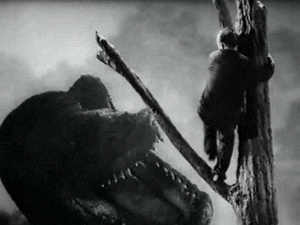
With Ann carried off by the “darkest leading man” in Hollywood, the back half of King Kong stops being an offensive stereotype parade and becomes an honest to God adventure film as the Venture-ers trek across Skull Island. The environment dogs their every step as (in true Lost World fashion) the Venture-ers are beset by dinosaurs…all of whom suffer from a rare form of reptilian rabies which drives them to attack humans on sight and attempt to eat anyone they catch, regardless of whether or not they happen to be herbivores.
Skull Island makes the Savage Land look like Disneyworld and, soon enough, only Denham and Jack remain alive. Denham heads back to the peninsula while Jack presses on. And even though Skull Island makes The Land Time Forgot look like the Mall of America, Jack succeeds, with he and Ann floating down the island’s suddenly-deserted river. Sure, it was full of angry sauropod yesterday, but today? Smooth sailing all the way back to the Wall.
Once there, Denham makes an intuitive leap that saves this film in my eyes even as it dooms Denham to become a Designated Hero. With half the crew dead and no “swell picture” to show for it, Denham gets a bug up his ass to capture Kong, using Ann as his bait. Thanks to the speed of Kong’s pursuit, Denham’s plan never gets much beyond the, “wouldn’t it be cool if?” phase. Kong’s destruction of the Black Gate and rampage through the native village gives every (white) person in the film time to board a boat and shove off. (You shove off!) They could just keep going back to the Venture, but Denham, who just can’t let anything go, gasses Kong into unconsciousness and proclaims
“We’re millionaires boys! I’ll share it with all of you! Why, in a few months, he’ll be up in lights, on Broadway: ‘KONG – THE EIGHT WONDER OF THE WORLD!'”
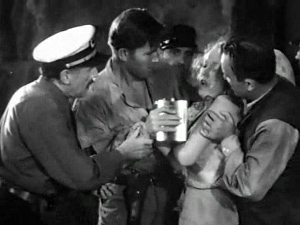
Here the film becomes something else and it was something no one expected. At this point, prehistoric animals had only rampaged through modern cities once before: in 1925’s The Lost World. (And since Skull Island makes The Lost World look like…actually, scratch that. The Lost World makes Skull Island look like a racist Disney cartoon.) Willis O’Brien also brought that rampaging animal to life, but no one cared about that brontosaurus, even if it was loose in London.
By contrast, everyone cares about King Kong and there’s a very good reason for that: Max Steiner’s incredible score. From the first Big Reveal of Kong’s giant, animatronic head to his last, ungainly pirouette off the top of the Empire State Building, Steiner’s score is there every step of the way. It’s not just telling us the story of the film – rising and falling along with the on screen action – any hack with some sheet music could do that. Steiner’s genius flows from his use of music to tell us not only what we’re seeing, but how to feel about it.
From Ann’s kidnapping, the score is a rousing, adventurous yarn of daring-do and plodding danger. The score becomes triumphant and celebratory after Kong’s kidnapping, and remains so during Denham’s stage show (“He was a king and a god in the world he knew; now he comes to you in chains for your own amusement”). Once King Kong escapes (rimshot!) we shift back to danger mode as he accosts random pedestrians while sniffing Ann out of New York’s crowds. (Man, that one whiff of her dress must’ve really stuck with him.) He succeeds, and the score makes sure we know The Climax Approaches with its rising, rising, rising themes that surmount their heights even as Kong does.
As my then-girlfriend said back in 2006, as we sat pondering Peter Jackson’s remake,
“The King of the world he knew, who up ‘til now has toiled and battled in utter obscurity, escapes the captivity imposed upon him by the modern world and literally pulls himself up to a point where everyone must look up to him. They have no other choice. He’s reached the Absolute Height…and at dawn, no less. Can’t get much more symbolic than that. The formerly obscure, the blackest of the black, this God of the fog jungles and ‘the last blank spaces on the map’ has surmounted the straight-line, brutally ninety-degree world of ‘civilization’ in the most ironically obvious of ways. The unknown, the ignored, makes himself impossible to ignore. So he has to die. We have to kill him, the way we kill everything he represents.”

Indeed. We have no other choice because Kong’s very existence endangers the entire project of modernity, with all its narratives of Progress and the inevitable benefits thereof. The prevailing currents of the time also leave this film with no choice but to kill Kong. After all, what do you think happened to tall, dark men (leading or supporting) accused of attempted white woman-napping?
So while the first half of King Kong is the plodding combination of African Expedition stories Cooper read as a child and a failed production of his called Creation, the back half of King Kong is the story of a lynching, as are most monster movies with a “sympathetic” creature as their main star. (See also that other Designated Classic of the early-30s, James Whale’s Frankenstein.) I use sarcastic quotation marks because (as in Frankenstein) there’s fuck-all signs of sympathy for Kong in the script, and most of his close-ups are meant as shock-shots – ancestor of our modern Jump Scares. The few exceptions come in the Climactic Action Sequence atop the spire, when lingering close-ups of Kong’s face, scrunched in pain and consternation at his first encounter with machine gun bullets, cement him as creature capable of feeling in the audience’s mind.
Steiner’s score comes in as soon as blood loss makes Kong slip, telling us in no uncertain terms that – even though this is a traditional happy ending – there’s an element of tragedy to all this that the film can’t escape. Here’s this embodiment of all the glories and the horrors of a wild, unknown world, so what do we do with it? Bring it back home in chains, put it up on display, and then shoot it when it dares to take exception to that. I know for a fact Cooper saw this for the shameful, wasteful loss it was, because when the once-thought-to-be-mythical Komodo dragon Ernest B. Schoedsack brought back to the Bronx Zoo died, Cooper (with the appropriate level of Carl Denham melodrama, I’m sure) declared it “killed by civilization.”
I also suspect Cooper, Schoedsack, and everyone else involved ran around like headless chickens, telling anyone who would listen “Don’t read too much into this flick. It’s just a silly monster movie.” I’d counter with the same rhetorical trick: don’t read too much into my reading. I haven’t even really scratched the surface of this film.
It’s not like I hate it. How could I? It’s the first diakaiju movie! I practically owe it my life. But it’s a long way from my favorite film and far from my favorite of the genre. Hell, it’s not even my favorite King Kong movie…but now that I’ve tackled this one (and held it down, and pummeled its ribs like the dirty-fighting punk that I am) we can actually get to that sometime soon.
![]()
![]()
![]()
Author’s note: Much better reviews (unlike the mad thing you’ve just sat through, which is more like an “overview,” but whatever) of King Kong live here, here, here and here.

Great review, some very insightful points. I get carried away by the fact that when I was a kid I missed the subtext and just saw it as a movie with a lot of monsters in it, and now I appreciate the performances by Wray and Armstrong and the effects, but it is quite ugly if you think about it for even 2 seconds and it is definitely flawed, if compelling viewing. I find it very interesting indeed, the story of the Komodo dragon.
As soon as I heard that story, in an off-hand comment on one of the Making Of docs Peter Jackson shot for Kong’s Ultra-Mega-Super-Ultimate-Deluxe Edition DVD, I said, “Heidegger’s balls! I knew it! No more of this ‘we just wanted to entertain’ shit, Merian C. Cooper. You knew exactly what you were doing and why.” I’d forgotten Komodo dragons were myths (as far as New Yorkers were concerned) until 1912, when a zoologist named Peter Ouwens bought a photograph and a bit of skin off a Dutch colonial Lieutenant with one of those great, Dutch colonial army names: Lieutenant van Steyn van Hensbroek.
At the time, one Henry Fairfield Osborn, the USGS paleontologist who (among other things) named and described both the T. Rex and the Velociraptor, was in charge of the American Museum of Natural History in New York. So when a big game hunter, “adventurer” and all-around rich person named W. Douglas Burden (who knew Ouwens) walked into his office in 1926 with tales of “land alligators” Osborn jumped at the idea. The expedition Burden paid for and led brought back twelve dead dragons, three of which are still on display at the AMNH, and two live ones, who wound up achieving minor celebrity in their new surroundings at the Bronx zoo. Burden’s also the man who popularized the phrase “Komodo dragon,” over Ouwens’ scientific classification, Varanus komodoensis…which incidentally explains Varan’s name.
Cooper initially planned to film real gorillas and Komodo dragons fighting it out, but that proved to be a crazy idea, even by Golden Age Hollywood standards. And frankly, thank God.
I knew the last part (the live animals fighting) and, agreed, THANK GOD.
Thank you for the information.
You don’t like Blade Runner??
Oh well, I don’t care for The Dark Knight.
Nah, it’s not like that. I like Blade Runner just fine. Other people hate it, though, and I didn’t wanna call them out by name because I kinda sympathize with their reasoning. (Oops, too late, now.)
Actually I hate both E.T. and The Rocky Horror Picture Show.
Plenty enough to hate about them both, though it’s been far too long since I’ve seen either. Can’t really follow that up with anything other than, “There, you see? Knew it wouldn’t take much prompting.”
That’s a really weird juxtaposition, now that I think about it. One is a sentimental bit of wish-fulfillment fantasy from a talented young filmmaker with daddy issues out the yin-yang. The other is Rocky Horror…a decent soundtrack in search of a movie.
The Wizard of Oz is one of those classics that pissed me off when I saw it as kid. It turned Dorothy Gale from a smart, practical little girl into a simpering twerp who just wanted to go home and Oz from a visitable fairyland into just the dream of said simpering twerp.
I imprinted on King Kong when I was 7 or 8. The script may not give Kong any sympathy but I sure did. He punched dinosaurs! Then he got kidnapped and punched a train! And then he climbed the tallest building in the world and died. Damn. “Beauty killed the beast” my ass. Even at that age I knew that Denham killed Kong.
One of the weird things that struck me, when I watched the movie again recently, was that Denham is the hero of the movie. In the 1976 remake the oil man stand in is the villain and in the 2005 remake Denham is clearly an sleaze (who knows he’s a sleaze and is trying to convince himself that he’s not). But in the original? Denham’s just a guy trying to make a buck and the movie is okay with that.
Of course! It’s a Merian C. Cooper production, and Cooper was, first and foremost an outspoken Capitalist. He spent nine months in a Soviet prison camp during the Polish-Soviet War and, obviously, came back changed by the experience. One of my colleagues (I don’t remember who at the moment, unfortunately) made the interesting point that Kong could easily represent the lower classes’ repressed rage. We live in a time that all-but deifies New York City. We forget that, during the 30s, the United States actually boasted a rural population that viewed the cities as exploitative dins of sin and iniquity, and New York as the Modern Gomorrah. This makes Kong, the Beast from 20,000 Fathoms, Q, and (eventually) Godzilla, instruments of God’s wrath. After all, Wall Street caused the Crash, right? Serious businessmen lost a lot of sleep pondering the very real possibility of poor people rampaging through the streets.
Ah…for a simpler time…
Racism? In the 30’s? I first saw Kong, and for that matter Mighty Joe Young at the Saturday matinee in the segregated movie theater in Alabama in the 50’s. Was it shown to us as a cautionary tale? Did they know we would identify with the monsters? I cried when they killed them – my brother was into the airplanes. And nobody could figure out why Kong wanted that blond screamer. But then I was only 9 years old. And a dusky beauty of the colored race.
As far as I can tell, the only one who didn’t explicitly identify with the monster was his creator. Which makes sense when you think about it.
Great overview, but it made me sad. I loved this film as a child-it also gave me an undying love of a good monster flick. Channel 9 out of Chicago would play a whole series of them every Thanksgiving, and I was glued to set every time, all the way up until about 10 years of age. Then I didn’t see it for 25 years. I was excited to add that cool tin to my vast film collection-until I watched it. Everything you wrote is true. And I can never watch it with child-like glee again.
Well…maybe we can’t watch the whole thing with that same glee…but even I gotta admit, that Climactic Rampage through New York is pretty fuckin’ sweet.
As a black man, I was not offended by the black “savages” depicted in King Kong. Any 1930’s serial or adventure film like the aforementioned, The Most Dangerous Game, and Buck Rogers would always depict any foriegner inferior to any white american. The sterotypes that would grate my nerves were the ones depicted as American citizens. For example, any time I hear that high pitched voice of that dim witted black maid in Mildred Pierce I wanted to crack her in her jaw.
“For some it’s that ninety minute Vangellis music video that happens to star Harrison Ford, Blade Runner.”
I wish I could shake your hand. I hate the film possibly more than you do. Even if one enjoys the music and the (ugly) decor, how could anyone like such a boring piece of rubbish ? Get Harrison Ford and Sean Young the hell out of there and just focus on Sebastian and the trials of the replicants and you have, at least, a watchable film.
Thank you, sir. And here I thought my family and I were the only ones who identified with the replicants. It really is their film, same as Kong is the undisputed star of all the films that bare his name, save that one exception, where he shared the limelight with Godzilla. Now that I think about it, that’s probably the reason everyone mistakes Frankenstein for his monster (apart from the fact that they’re father and son).
I tend to be equal opportunity in my hatred of stereotypes, whatever their form. Which means I’m going to have fun boning up on how the Japanese preferred to represent their Savage Others before we meet Kong (and his baggage) again.
Defenders of Blade Runner claim that Deckard was suppose to represent the isolation of mankind in the future and he himself was a replicant. That still doesn’t excuse how useless the character was. All he did was slum around finding the replicants and was lucky that he didn’t get killed. I think JF Sebastian, The Replicants, Gaff and Tyrell were more than enough to carry the story. We didn’t need Ford or Young’s personal problems because they just slowed the film down every time they were on screen.
Getting back to stereotypes, what really annoys me is not so much the depiction of blacks back then but more like their status. Even if the film was about poor white people, blacks were still at the bottom of the food chain.
By the way, when are you going to tackle a Bond film ? I want to see you trash Die Another Day. Heh Heh.
What, Bad Boys II wasn’t enough of an early-21st century Action nightmare?
Never saw BB II. Unfortunately, I did see The Island. Ugh.
Which reminds me to give everyone their homework for Wednesday: Parts: The Clonus Horror. The MST3k episode is still on Google, as far as I know, but it’s fairly easy to find as these things go, and that way we’ll all be on the same page.
Actually, I’ve never watched MST3k, for the same reason I hate The Rocky Horror Picture Show- both insult my favorite movies.
And i don’t like E.T. because the mixture of sentimentalism & anti-intellectualism turns my stomach. Anti-intellectualism is a lot easier to tolerate when the alien is a murdering monster.
I have to admit that King Kong is my all time favorite movie, even though I tend to agree with most of his criticisms. My favorite scenes are what I call the “smaller” scenes. Like the way Mr. Steiner’s score hits a note every time the native chief takes a step toward the sailors.
Or, when the T-Rex kicks Kong to the ground and then jumps up with a challenging “Come on sucker!” wag of it’s tail.
Or the glimpse of the pterodactyl flying past in the background before swooping down on hapless Ann.
And, check out the old lady in the spotted dress in the background at the end of the movie. Her reactions to Denham’s remarks are priceless.
But, there is one huge plot hole that I’ve only heard one other person address: Why would the natives build a gate large enough for Kong th fit through!